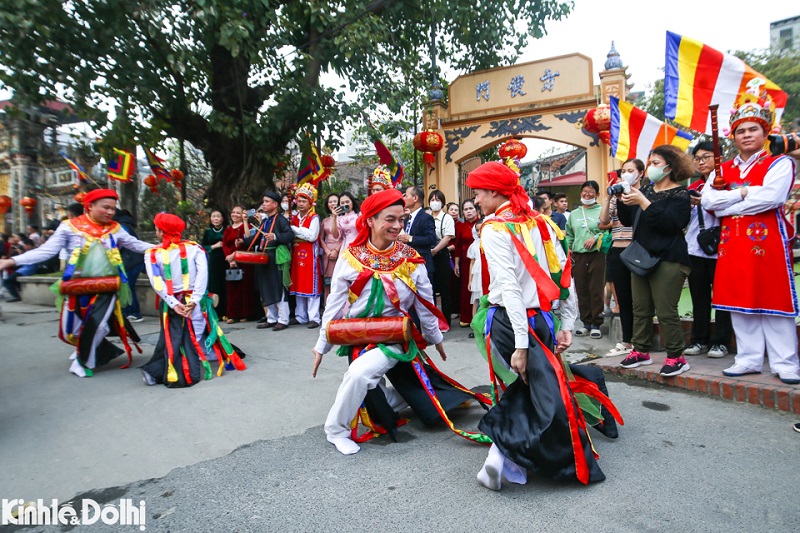As one of Vietnam’s most prized cultural traditions, the ancient Thang Long dances are a testament to the country’s rich heritage.
 |
|
A vibrant folk dance performance by local artists in Trieu Khuc Village captivates the audience. Photo: Ngoc Tu/The Hanoi Times |
Located in the historic village of Trieu Khuc, which spans across Thanh Xuan and Thanh Tri districts, lies a treasure trove of cultural heritage. Here, the Con di danh bong (Flirtatious Girls Playing Tom-tom) folk dance has been meticulously preserved, with its origins dating back to the eighth century.
Legend has it that a king once held a ceremonial dance involving men dressed as women to boost the morale of his soldiers before a pivotal battle against invaders. This unique tradition has been carefully handed down through generations, with local artists dedicated to its preservation.
In Le Mat Village, Viet Hung Ward, the Giao long (Kill the River Dragon) dance is performed annually from the 20th to the 23rd day of the third lunar month. This dance commemorates a brave man who slew a river monster, rescued a princess, and brought peace to the land. He was revered as a guardian and the founder of the village.
 |
|
Le Mat Village artists perform the captivating “Kill the River Monster” dance, a highlight of their cultural heritage. Photo: The Hanoi Times |
These two folk dances are among the few that have been carefully preserved in Hanoi, thanks to the dedicated efforts of local artists and enthusiasts. Recognizing the importance of these ancient dances, artist Nguyen Van Bich, former president of the Hanoi Dance Artists Association, initiated a project in 2005 to study and compile the ancient dances of Thang Long-Hanoi.
Despite limited resources and aging dancers, the passion and commitment of these artists have kept the traditions alive. Over 50 dances have been collected, with eight fully restored and filmed, ensuring that the essence of these dances is captured for future generations.
The Hanoi Dance Artists Association has played a pivotal role in promoting and preserving these ancient dances. They have organized four festivals and two major folk dance events, each attracting over 800 dancers and artists. Additionally, they plan to introduce folk dances to locals and visitors, raise awareness among the youth, and collaborate with educational institutions to teach ancient dances in schools.
The association also foresees cooperation with the Vietnam National Authority of Tourism to develop a unique product featuring the Thang Long-Hanoi ancient dance as its centerpiece. This initiative underscores the importance of involving professional art agencies in preserving and promoting Vietnam’s and Hanoi’s cultural industries.
However, the rapid urbanization and passing of elders with knowledge of these dances pose significant challenges to preservation efforts. Despite these obstacles, the dedication of local artists and enthusiasts keeps the ancient dances of Thang Long-Hanoi alive, ensuring that these traditions continue to thrive and captivate audiences for years to come.

